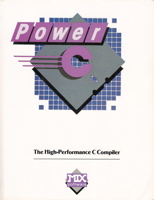 While I was home for Christmas, I found a book I hadn’t seen in a while: a computer programming manual for Power C, a C compiler from Mix Software. My parents sent away for it when I was about 12 years old. At $19.95 it was quite a steal since it included an ANSI-compliant C compiler and a printed manual with a good tutorial. I remember poring over it trying to take it all in. I learned pointers, memory management, and linked lists. For an additional $19.95, we bought the debugger. I could see the values of variables in real time and step through programs. It was fun.
While I was home for Christmas, I found a book I hadn’t seen in a while: a computer programming manual for Power C, a C compiler from Mix Software. My parents sent away for it when I was about 12 years old. At $19.95 it was quite a steal since it included an ANSI-compliant C compiler and a printed manual with a good tutorial. I remember poring over it trying to take it all in. I learned pointers, memory management, and linked lists. For an additional $19.95, we bought the debugger. I could see the values of variables in real time and step through programs. It was fun.
My proudest programming moment was creating a Terminate and Stay Resident program that helped me play an online game. The game was Flash Attack and it ran on Galacticomm BBS‘s. (Despite having to dial into a bulletin board system to play it, that my computer was slow, and that the game used primitive text graphics, it was pretty fun to play with other people.) The game would let you shoot a laser beam at oncoming tanks, but you had to type in the trajectory of the laser beam in degrees and that obviously wasn’t easy to do in a hurry when tanks were attacking.
So I built a program that ran in the background, looking for oncoming tanks by watching for the diamond shape in the video card’s memory area. If it saw a tank, it would calculate the trajectory of the laser beam, type it in, and press “L” to shoot the laser. It was like having a bug zapper for my base; any time a tank came near it would automatically be shot. (Including my tanks, so I had to be careful where I drove.) It was a big project for me because I had to learn direct memory access to the graphics system, hook into system interrupts to stay resident in the background, how to “stuff” the keyboard with keystrokes, and a little trigonometry.
That Power C manual taught me everything I know about C. Since I now make my living as a PHP programmer, and especially because PHP is modeled after C, I can safely say the Power C manual has had more influence on me than any other technical book! Thanks, Mix Software!
NOTE: I had never searched for Mix Software on the Internet, but while writing this entry I was surprised to find that Mix Software is apparently still in business and Power C is still available at the same price!
